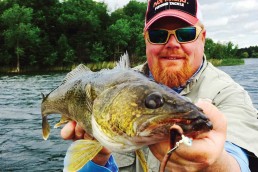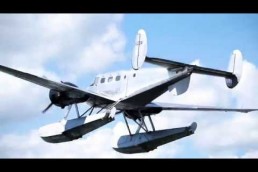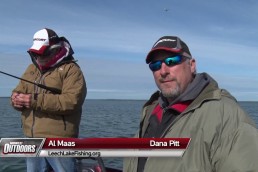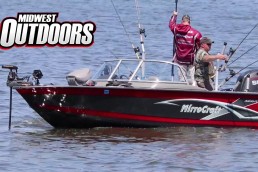Tempt Multiple Walleye Senses for Success
SHARE THIS POST
Summer in Minnesota can be hard to pin down on a calendar, especially with each year a little different from the last. Now is the time with the warmest temperatures, so that makes it as close to summer as it gets in northern Minnesota.
An easier definition of “summer,” as far as fishing is concerned, refers to the part of the year when surface water temperatures are warmer than 70 degrees (measured in the morning, before the sun hits the water). Summer fishing patterns for walleyes on Leech Lake and many others in the Upper Midwest usually involve appealing to as many of the walleyes’ senses as possible. These senses include sight (flash and color), hearing (vibration and sound), scent (live bait or scented plastics), size (blade, beads and profile) and speed.
Vertical depth (suspended walleyes) and spreading out horizontally (planer boards) are other factors that can come into play on some walleye lakes. Covering as much of the “right water” as possible is an important part of the equation, regardless of the presentation.
Many anglers consider bottom-bouncers with spinners the go-to presentation for walleyes during summer. The basic bottom-bouncer and spinner rig can be broken down into its most basic components.
Many walleye anglers like to tweak their presentations by using different sizes, shapes and colors of spinner blades. There are also important bead patterns and finding a combination that gets the most bites or catches the biggest fish. It is usually a good idea to match the presentation to the natural forage when it comes to picking colors for walleye spinner rigs. The main forage species for walleyes in Leech are perch, shiners, suckers and crayfish.
Perch colors are combinations of green, yellow, orange and white. Shiner colors are silver and black or gold and black with tints of red, pink, blue and emerald green. Sucker colors are gold, copper, white and red. Crayfish colors are brown, gold, copper and orange with tints of red and green.
The nearly infinite combination of spinner and bead patterns can cause anglers to resort to painting their own spinner blades and assembling their own components for spinner rigs. Some anglers also paint their own lipped minnow baits for walleyes with an airbrush, turning their garages into mini-home tackle shops. The basic rule of thumb is use smaller spinner blades and smaller beads in heavily pressured clear-water lakes and larger blades, brighter colors and more beads in lakes with stained or turbid water.
Sometimes the size of the spinner blade is impacted by the size of the fish. Anglers fishing in the Great Lakes or in some Canadian lakes with less fishing pressure use larger blades to try and target the larger fish.
Leech Lake is a clear-water lake with moderately pressured fish. The walleye bite during the spring and fall is wind-driven and shallow, but the summer bite is usually spread out onto the flats and areas around mid-lake structures.
The main basin on Leech Lake and the flats around the mouths of Portage and Sucker bays are where many walleyes in Leech spend their summers. The main lake portion is relatively shallow, so most of the lake is capable of holding fish. I’ll use my Humminbird Helix 10 along with a LakeMaster chip to highlight the contour depths to help my search for an active school.
Walker Bay acts like a separate lake during the summer, with water depths at 200 feet. Walker Bay sets up a thermocline during the summer, while the main lake doesn’t. I love to use my underwater camera here, even on steep-breaking structures where the fish cannot hide.
Are you enjoying this post?
You can be among the first to get the latest info on where to go, what to use and how to use it!
Anglers fishing the main lake area of Leech during summer are able to make successful, long trolling passes over the 15- to 25-foot flats with bottom-bouncers and spinners. Leech walleye anglers usually have fish respond to trolling speeds between 1.2 and 1.5 mph.
I like to use Northland Tackle’s Rock Runner Bottom Bouncers and Rock Runner Slip Bouncers, combined with Baitfish Image Blades and Crawler Hauler Hooks. Northland’s bottom-bouncers come in sizes from 1/4 ounce to 4 ounces, with the 1 to 1 1/2- or 2-ounced sizes as the best for most situations. The Rock Runners come in plain Lead, Sunrise or Parakeet. The color of the sinker can sometimes make a huge difference, so I keep all three colors handy.
The rod combinations I like to use for bottom-bouncers is a line-counter reel spooled with 20-pound-test Green Braid Sunline SX1 and a spinner rig with 10-, 12- or 14-pound-test Clear Sunline Fluorocarbon leader. I use a combination of a 7- to 8 1/2- foot St. Croix Legend Rods that I put in rod holders to spread them out and keep them from getting tangled.
Two of the most common mistakes anglers make when fishing bottom-bouncers is setting the hook at every bump and letting out too much line, so the whole rig is dragging limp on the bottom.
Letting out the right amount of line is critical, which is easier to do with line-counter reels. I will let out line at trolling speed and stop as soon as I feel the sinker hit the bottom and then take back 5 to 10 feet of line, making sure the whole rig is not dragging on the bottom.
Once I determine how much line to let out, I can tell my clients when to let out and when to take in line as the depth or speed changes.
Anglers should leave the rods in the rod holder and watch the rod tip closely. Anglers should be able to see the tiny vibrations of the spinner if everything is working right. Don’t take the rod out of the rod holder until the tip of the rod loads up with a fish. Then, don’t set the hook, just keep the line tight and don’t give the fish any slack by pumping the rod.
Summertime mortality of walleyes is greater due to heat and any mishandling of fish. I use a Frabill Conservation Series Net. The net bag doesn’t wipe the slime and the bag is wider, which does not allow the fish to curl up. The handle extends too, allowing you to snap up fish that are surfacing too soon.
If the spinner gets fouled or if perch or other critters keep pecking at the bait without getting hooked, anglers may have to reel in the rig and check the bait or take off the weeds. Most anglers use nightcrawlers on their spinner rigs, but I like to mix things up and use leeches or fathead minnows as well so I can let the walleyes decide which one they like best.
When I get on a bite with too many perch or smaller fish, I take off the live bait and use a plastic to sort through the critters and get to the walleyes.
Brian “Bro” Brosdahl is a nationally known fishing guide and lead spokesman for many of the top companies in ice fishing. He can be contacted at bbro@paulbunyan.net or through his website at brosguideservice.com. Follow him on Instagram, Twitter and Facebook.
MWO
SHARE THIS POST
Did you enjoy this post?
You can be among the first to get the latest info on where to go, what to use and how to use it!
Brian 'Bro' Brosdahl
Outdoor communicator Brian “Bro” Brosdahl lives in northern Minnesota. He is a walleye guide in the Cass Lake, Leech Lake and Lake Winnibigoshish areas. He is sponsored by Northland Fishing Tackle, Frabill/Plano, Aqua-Vu, Humminbird/Minn Kota, St. Croix Rods, Ranger Boats, and Evinrude. Guide inquiries: brosguideservice.com. Follow on social media.



